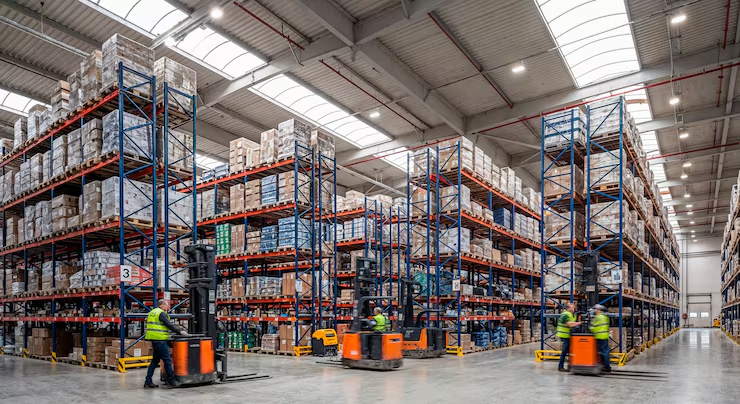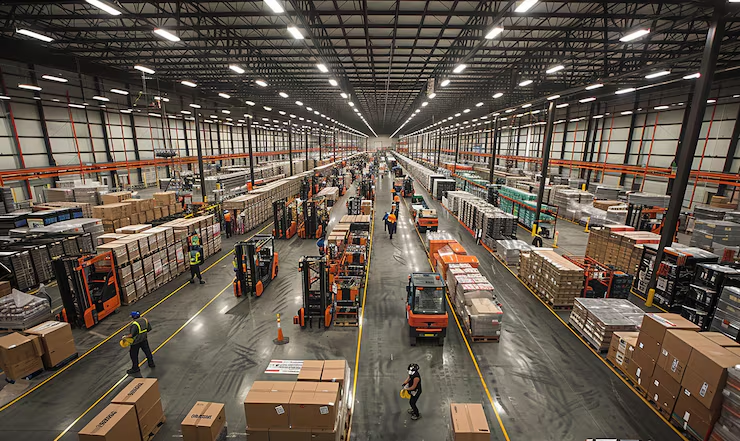If you run a business in New York City, chances are you’re already familiar with the challenges of managing space, logistics, and customer expectations. With limited square footage, tight delivery windows, and high operating costs, finding a reliable storage or warehousing solution is critical to staying competitive.
Here, we’ll walk you through how to choose the best storage & warehousing service in NYC and how to make sure the service you choose fits your business goals.
Table of Contents
Key Takeaways✔ Choose a provider that offers flexible, secure, and climate-controlled storage options tailored to both short- and long-term needs. ✔ Opt for a warehousing partner that integrates with your systems and manages fast, accurate order fulfillment and returns handling. ✔ Select a strategically located facility near major transport hubs that supports last-mile delivery and efficient loading access. ✔ Partner with a warehouse that can scale space, staffing, and services as your business grows or experiences seasonal spikes. ✔ Prioritize providers with real-time inventory tracking, automation tools, and robust warehouse management systems to ensure accuracy. ✔ Work with a warehousing service that offers clear pricing, strong customer service, and a proven track record in NYC logistics. |

6 Key Features to Look for in NYC Storage & Warehousing Services
When evaluating how to choose the best storage & warehousing service in NYC, businesses must look beyond just square footage. The right provider should not only store your products securely but also enhance your logistics workflow, reduce operational friction, and support your bottom line.
1. Comprehensive Storage Solutions
What services are included in NYC warehousing and storage packages? Before signing on the dotted line, make sure the provider offers a full spectrum of storage services tailored to your needs.
- Climate-Controlled Storage: NYC weather swings wildly between humid summers and icy winters. Climate-controlled facilities protect sensitive inventory like electronics, cosmetics, and perishables from extreme temperatures and moisture damage.
- Pallet Racking & Bin Storage: Check if the warehouse has flexible shelving and pallet options. If your items vary in size or require segregation, customized storage layouts can be crucial.
- Short-Term & Long-Term Options: You may need a few weeks for overflow storage or years for long-term supply housing. Look for providers who offer flexible rental periods to accommodate business fluctuations.
- Security & Surveillance: Ensure 24/7 camera monitoring, gated entry, motion sensors, and inventory logging are part of the service package. This is standard for high-quality NYC storage services.
2. Fulfillment & Distribution Capabilities
How do storage & warehousing services in NYC handle fulfillment? A modern warehousing service isn’t just about storing goods—it’s about moving them efficiently.
- Order Picking & Packing: Top-tier services have streamlined picking processes, barcode scanning, and professional packaging options to ensure speed and accuracy.
- Same-Day & Next-Day Shipping: Especially in NYC, where customer expectations are high, partnering with a provider that offers rapid shipping through USPS, UPS, FedEx, or local couriers gives you a competitive edge.
- E-commerce Platform Integration: Providers should integrate with your systems (Shopify, Amazon, WooCommerce, etc.) to automate order intake and fulfillment. This eliminates manual work and reduces errors.
- Returns Processing: A comprehensive fulfillment service also manages reverse logistics—handling customer returns, inspections, restocking, or disposal if necessary.
3. Prime NYC Location & Accessibility
How to choose the best storage & warehousing service in NYC? Location is half the battle.
- Proximity to Major Transport Hubs: Warehouses near JFK, LaGuardia, Port Authority, or main highways (like I-95 or the BQE) ensure fast inbound and outbound logistics.
- Last-Mile Delivery Support: In NYC, last-mile delivery can make or break your logistics plan. Look for providers with partnerships or internal fleets that understand the intricacies of navigating city routes and traffic.
- Zoning & Loading Dock Access: The right warehouse will be located in properly zoned areas and offer easy access for trucks or vans. Some even offer night-time or weekend access for flexible scheduling.
4. Scalability & Customization
Business growth shouldn’t mean jumping to a new provider—especially as the global warehousing and storage services market is projected to grow to USD 919.17 billion by 2033, making scalability more essential than ever.
- Adjustable Square Footage: As your inventory ebbs and flows, your space needs will too. Find a warehouse that allows you to scale up or down without penalties.
- Custom Service Packages: Not every business needs the same things. You might need kitting, labeling, or specialized packaging. Providers should allow you to build a package that reflects your business model.
- Dedicated vs. Shared Warehousing: Some services offer dedicated zones for your inventory, while others use shared space. Know the difference and choose what suits your budget and security needs.
- Peak Season Readiness: Can they handle increased volume during holidays or promotional campaigns? Your provider should have surge capacity and temporary staff availability.
5. Technology & Inventory Management
When knowing how to choose the best storage & warehousing service in NYC, A digital-first approach improves accuracy and customer satisfaction.
- Real-Time Inventory Tracking: Look for platforms that allow you to check your stock levels, order status, and delivery progress in real time. Transparency is key to good operations.
- Warehouse Management System (WMS): Ask about their tech stack. A robust WMS can streamline order processing, minimize errors, and help with forecasting.
- Barcode & RFID Scanning: These technologies ensure proper tracking of each item through the warehouse lifecycle, from arrival to shipping.
- Automated Alerts & Reporting: Want to know when stock is running low? Need a weekly report on outbound volume? Choose a provider who offers automated communications and detailed dashboards.
6. Transparent Pricing & Reliable Support
What are the benefits of outsourcing to a warehousing service in NYC? Predictable costs and expert service are two big ones.
- Clear Cost Structure: Avoid surprises by choosing a provider that breaks down fees by service: storage per pallet, handling, pick-and-pack, shipping, etc. Hidden fees can wreak havoc on your margins.
- Onboarding Support: The transition into a new warehouse should come with a dedicated account manager and a step-by-step migration plan to minimize disruption.
- Customer Service & Responsiveness: Things will go wrong. What matters is how fast your provider responds. A great warehouse partner will offer 24/7 support or at least quick daytime resolution via phone, email, or chat.
- Reputation & Reviews: Check testimonials, Google reviews, and B2B directories like Clutch or GoodFirms. Reputation goes a long way in vetting long-term partners.
How to Overcome NYC-Specific Storage Challenges
Operating a business in New York City comes with unique logistical hurdles. From limited real estate and strict zoning regulations to high labor costs and traffic congestion, storing, managing, and fulfilling inventory in NYC is no small feat. Fortunately, with the right strategies and partners, these challenges can be turned into growth opportunities.
1. Combat Limited Space With Smart Storage Solutions
NYC’s tight footprint and sky-high rents make space a premium commodity.
- Vertical Storage Optimization: Warehouses that utilize vertical racking systems can significantly increase your inventory capacity without expanding the square footage footprint. This is especially important for businesses in NYC, where floor space is scarce and expensive.
- Multi-Use Storage Configurations: Select facilities that offer customizable bin storage, pallet shelving, and mezzanine structures to make the most of limited space. When evaluating what services are included in NYC warehousing and storage packages, prioritize providers who offer modular solutions.
- Shared Warehousing Options: For small to mid-sized businesses, shared or multi-client warehouses help keep costs low while maximizing utility. This approach also gives you flexibility as your inventory fluctuates.
2. Solve Traffic & Delivery Delays with Strategic Fulfillment
Congested streets, unpredictable delivery windows, and narrow time slots define urban logistics in NYC.
- Last-Mile Delivery Expertise: Understanding how do storage & warehousing services in NYC handle fulfillment is essential in a city where “last mile” delivery can be the longest leg of the journey. Choose providers that offer last-mile delivery with local carriers or operate their own NYC-based fleet.
- Micro-Fulfillment Centers: Smaller, decentralized warehouses closer to your customer base help shorten delivery times and reduce the risk of traffic delays. Some services even use borough-based storage nodes to improve speed.
- Off-Peak Scheduling & Night Dispatching: Warehouses that schedule shipments during low-traffic windows (early morning or late at night) can dramatically improve delivery reliability.
- Courier & Dock Coordination: Inquire whether your provider can coordinate with couriers for fast handoffs and maintain scheduled loading dock appointments. This helps ensure smooth, predictable fulfillment workflows.
3. Manage High Operating Costs with Efficient Outsourcing
Rent, utilities, labor, and real estate in NYC are among the highest in the country.
- Outsource to Reduce Overhead: One of the benefits of outsourcing to a warehousing service in NYC is reduced operating costs. You avoid leasing your warehouse, hiring fulfillment staff, and investing in costly infrastructure.
- Bundle Services to Cut Expenses: Many warehouses offer bundled pricing that includes storage, pick-and-pack, labeling, and returns. When evaluating what services are included in NYC warehousing and storage packages, choose all-in-one solutions to reduce complexity and cost.
- Usage-Based Billing: Select a provider that charges based on actual usage (e.g., per pallet, per order) instead of fixed monthly rates. This helps you manage seasonal shifts in inventory without wasting money on unused space.
- Shared Labor Pools: Warehousing partners often pool labor across clients. This means you gain access to a trained team of warehouse workers without directly hiring or training them, keeping your HR overhead low.
4. Avoid Zoning Pitfalls with Expert Facility Selection
Zoning restrictions and compliance requirements can derail your storage strategy if overlooked.
- Work with Zoned Facilities: Ensure that the warehouse you partner with is located in areas zoned for commercial and industrial use. This is vital for legal operation and future scalability.
- Permits and Fire Code Compliance: NYC has strict fire safety regulations and building codes. Choose a facility that can show up-to-date certifications and inspections, so you aren’t caught off guard during audits or emergencies.
- Logistics-Friendly Neighborhoods: Areas like Long Island City, Sunset Park, and parts of the Bronx are more industrial and fulfillment-friendly than densely populated zones like Midtown. Ask your provider about how their location improves operational flow and reduces risk.
5. Improve Inventory Control with Technology
Space constraints and high turnover rates demand sharp inventory visibility and control.
- Real-Time Stock Management: Many NYC warehouses now offer cloud-based platforms that sync with your inventory and sales systems. These platforms allow you to track stock levels, order status, and fulfillment workflows from anywhere.
- Barcode & RFID Tracking: Tagging inventory with barcodes or RFID chips ensures every item is traceable—minimizing shrinkage and improving accuracy. This also contributes to the 25–30% cost savings that automated solutions like robotics can deliver, according to Warehouse Industry Insights.
- SKU-Level Insights: Need to forecast demand? Choose a provider that offers SKU-level reporting so you can identify your fastest-moving items and avoid dead stock.
- Automated Alerts: Set up alerts for low inventory, late deliveries, or discrepancies in stock count. This level of automation allows you to be proactive rather than reactive.

How to Vet and Compare NYC Storage Providers
Choosing the right storage and warehousing provider in New York City can significantly impact your operational efficiency. With countless options and a highly competitive landscape, it’s not enough to choose the first warehouse you find with space. You need a structured approach to evaluate and compare providers based on features that truly matter.
1. Define Your Business Needs and Volume Requirements
Before comparing vendors, understand your own logistics profile.
- Inventory Type & Sensitivity: Are you storing perishables, electronics, fashion apparel, or bulky items? Knowing your product profile helps filter out providers who aren’t equipped to handle your specific needs.
- Volume & Turnover: Identify your average monthly inventory volume, order frequency, and seasonal spikes. High-turnover businesses may need providers with optimized picking and packing processes.
- Special Handling Requirements: If your products require refrigeration, hazardous material protocols, or extra security, make sure these services are on your checklist when comparing vendors.
- Fulfillment Channels: Are you fulfilling direct-to-consumer orders, bulk B2B shipments, or both? Understanding how do storage & warehousing services in NYC handle fulfillment for your channels is key to narrowing down your options.
2. Visit Facilities and Inspect for Quality
A warehouse tour can reveal more than a brochure ever will.
- Cleanliness & Organization: A clean, well-organized warehouse reflects operational discipline. Disorganized spaces can signal poor inventory control and higher risk of lost or damaged goods.
- Security Measures: Look for access controls, surveillance systems, visitor logs, and alarm protocols. If your inventory is valuable, robust security is non-negotiable.
- Staff Professionalism: Observe how the staff handles incoming/outgoing shipments. Trained personnel reduce the risk of human error and delays.
- Loading Dock Access: NYC traffic and tight delivery schedules require streamlined loading procedures. Make sure the warehouse has sufficient dock space and understands urban delivery constraints.
3. Assess Customer Support and Reputation
Exceptional logistics support is just as critical as storage space.
- Dedicated Account Manager: Providers with a dedicated point of contact can solve issues faster, provide regular updates, and align better with your business goals.
- Response Times: Ask how quickly they respond to order issues, damage claims, or urgent rerouting requests. A 24–48-hour window is standard, but best-in-class providers often reply same-day.
- Client Reviews and Testimonials: Check reviews on Google, Yelp, and B2B platforms like Clutch or GoodFirms. Look for case studies that describe success stories in your industry.
- Disaster Recovery Protocols: Ask what happens during a fire, flood, power outage, or system downtime. A reliable partner will have contingency plans and insurance policies in place.
4. Analyze Turnaround Times and SLA Commitments
In a fast-paced market like NYC, speed isn’t a luxury—it’s a requirement. Speed also answers a critical question: what are the benefits of outsourcing to a warehousing service in NYC?
- Order Processing Speed: Ask about their average turnaround time for receiving, order picking, packing, and shipping. The best providers offer same-day or next-day turnaround for most orders.
- Inbound Receiving Times: Delays in checking in inventory can disrupt your entire fulfillment chain. Look for providers who commit to receiving and shelving new inventory within 24–48 hours.
- Service Level Agreements (SLAs): Reputable storage companies should be willing to commit to measurable SLAs for order accuracy, shipping speed, inventory accuracy, and damage rates. These commitments protect your business and build trust.
- Peak Season Performance: Ask how they handle order volume during Q4, holidays, or major promotions. Reliable providers have scalable systems and staffing in place to maintain SLAs during rush periods.
Frequently Asked Questions (FAQs)
What's the difference between warehousing and storage?
Storage typically refers to short- or long-term holding of personal or business items in a basic, secure unit—ideal for overflow inventory, seasonal equipment, or household goods. In contrast, warehousing includes not only the storage of goods but also a suite of logistics services such as inventory management, order fulfillment, packing, shipping, and returns processing.
How much does storage cost per month in NYC?
The monthly cost of storage in New York City depends on unit size, location, and facility features. On average, NYC customers pay around $60 per month for a 5×5-foot unit and about $250 per month for a 10×10-foot unit. Disclaimer: Actual pricing varies by provider, lease term, and available amenities, so it’s best to request quotes from multiple facilities to get accurate estimates.
What are the 5 main activities in a warehouse?
The five main activities in a warehouse are receiving, put-away, storage, picking, and shipping. Receiving involves checking and logging incoming inventory. Put-away refers to placing items in their designated locations for efficient retrieval. Storage ensures goods are safely housed until needed, with consideration for space optimization and accessibility. Picking is the process of retrieving items to fulfill orders, and shipping involves packing and dispatching goods to customers or other destinations.
What is the role of the warehouse storage system in the order fulfillment process?
A warehouse storage system is central to the efficiency and accuracy of the order fulfillment process. It organizes inventory in a way that maximizes space while allowing fast access to products during picking. By maintaining precise records of item locations, quantities, and movements, the system helps reduce picking errors, prevents stockouts, and supports real-time inventory tracking.
Why outsource warehousing?
Outsourcing warehousing allows businesses to save on infrastructure, labor, and logistics costs while gaining access to expert fulfillment services and scalable space. Third-party providers manage everything from storage and inventory control to picking, packing, shipping, and even returns—freeing businesses to focus on core functions like sales and product development. Knowing what are the benefits of outsourcing to a warehousing service in NYC enables faster expansion into new markets without the upfront investment of opening and staffing additional facilities.

Optimize Your NYC Logistics Strategy with the Right Partner Today
Choosing the right warehousing and storage solution in New York City isn’t just a logistical decision—it’s a strategic one. That’s where 3PL Logistics by Best stands out. Our short-term storage options are ideal for handling seasonal demand or project-based overflow, while their full-service warehousing solutions are built around your real-world operation—offering flexibility, speed, and efficiency without generic, one-size-fits-all systems.
Ready to make your storage and fulfillment smarter? Reach out to 3PL Logistics By Best today.

